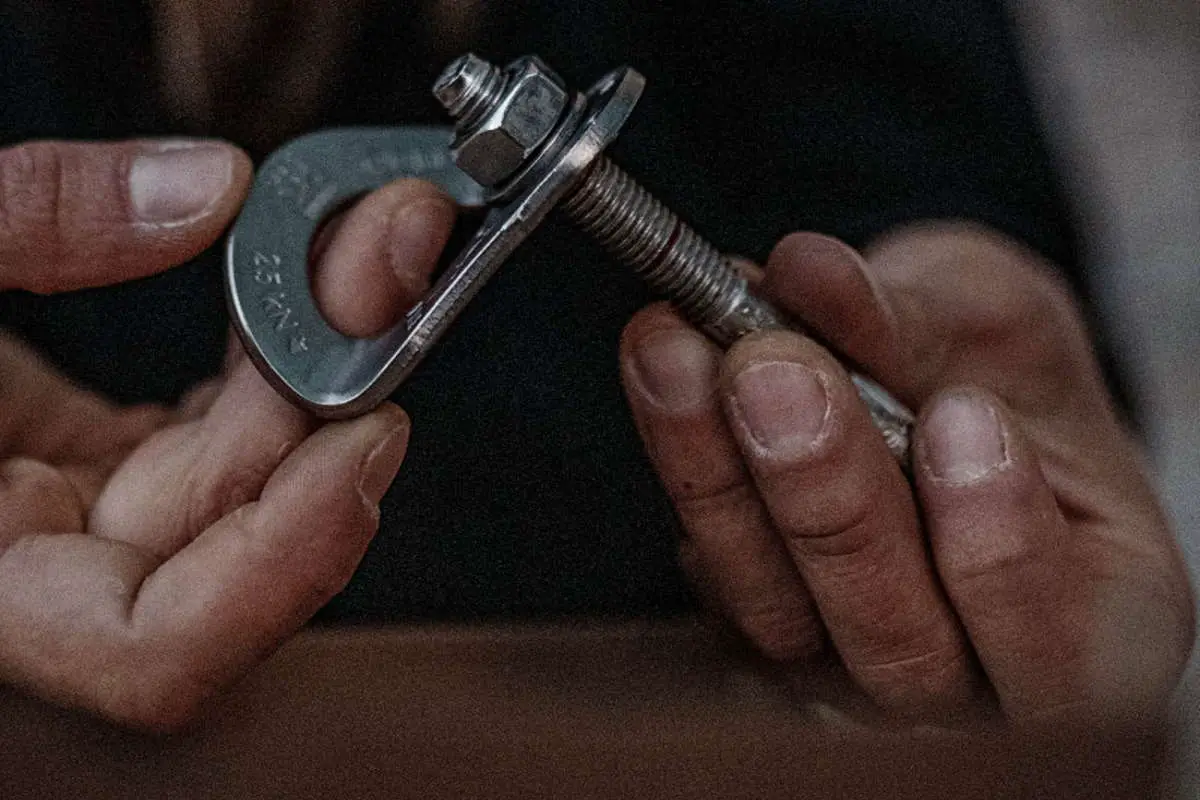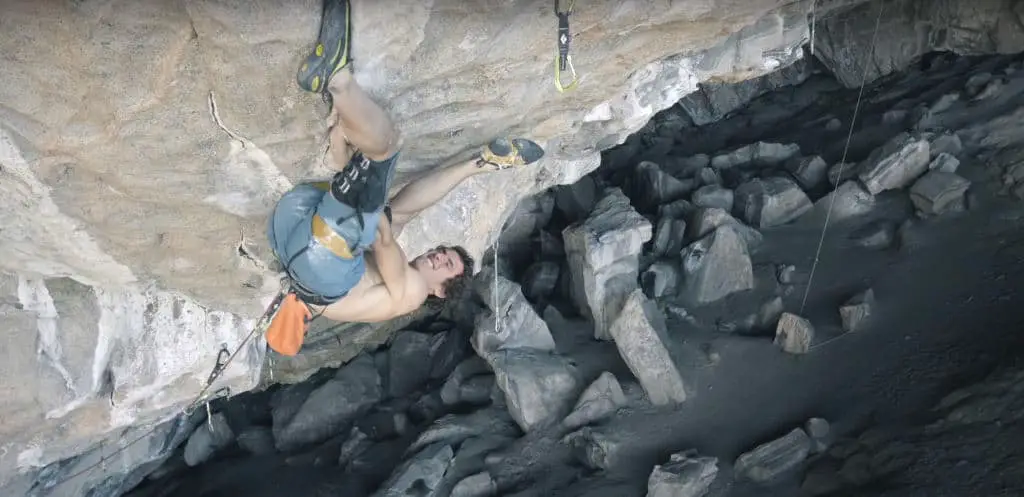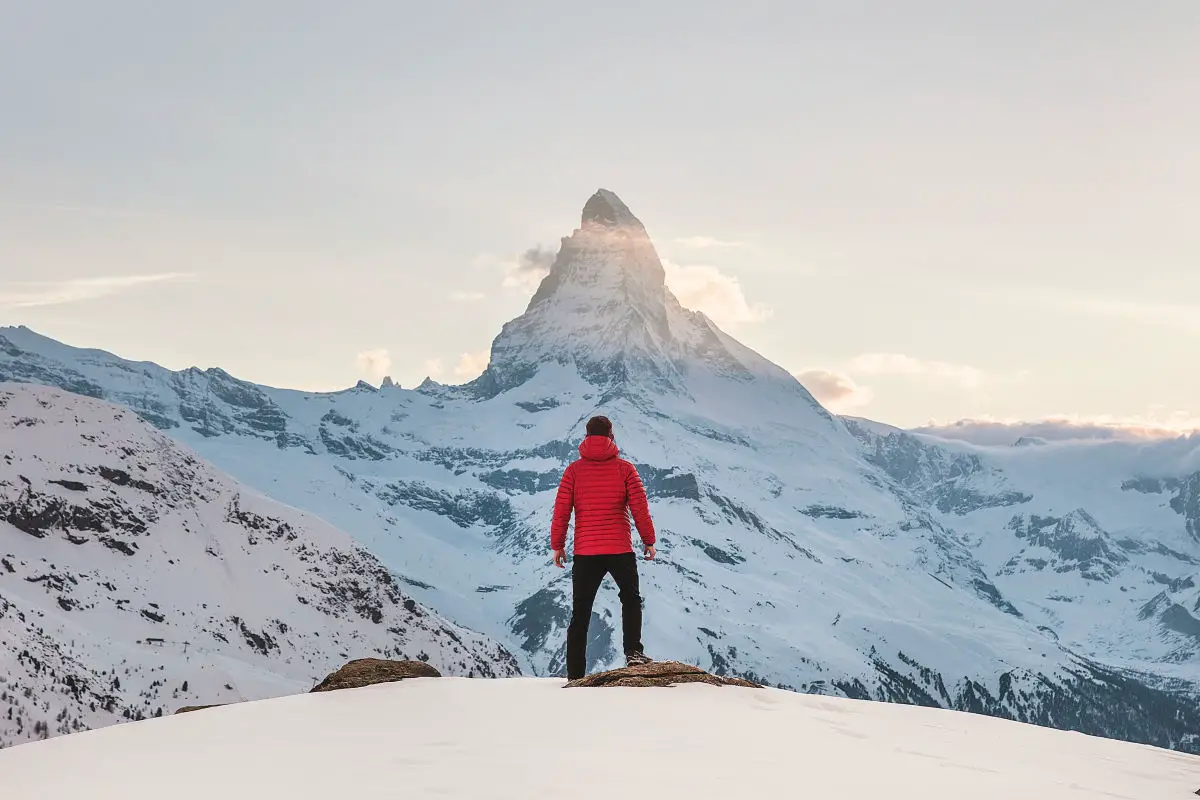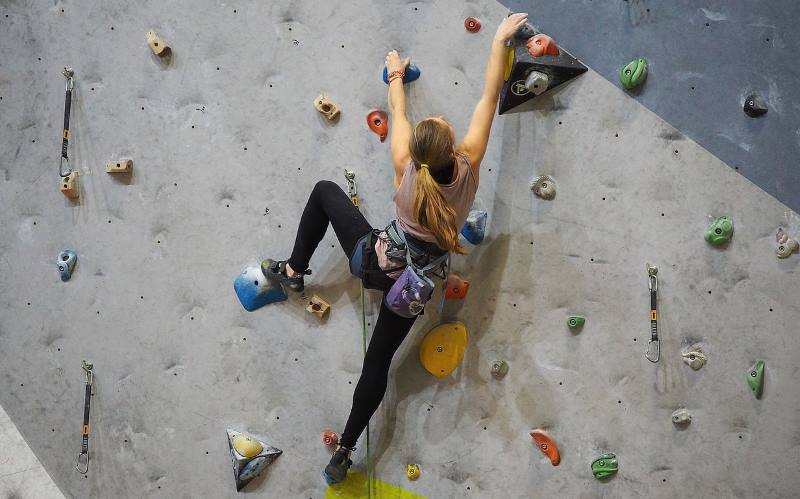Slab climbing is hated by many but loved by the dedicated. Climbing slab requires good technique, precision, and trust in your abilities. If you learn a few tricks, you’ll find yourself much better equipped to take on big days out on friction slab or that weird slopey problem at the gym.
What Is Slab Climbing?
Slab climbing is any climbing at an angle less than 90 degrees – aka any wall you can learn forward on to. You’ll also find friction slab, meaning a slab angled where you’re mostly relying on friction instead of defined holds.
If a climb leans backwards as you climb it’s an overhang, if it goes straight up it’s vertical. A rock face or an indoor wall might have all three angles on the same wall but commonly a climb will be mostly one angle. Slab is generally the easiest of the three angles but that depends a lot on the holds and the protection.
What Angle Is Slab Climbing?
Slab climbing is technically any angle less than 90 degrees from horizontal. Anything with 5 or so degrees off of 90 has more in common with vertical climbs but would still count as slab. Slab can be tonnes of different angles and generally the steeper “high angle” ones are harder, though it’s much more about the features and the rock than the angle.
Low Angle / High Angle Slabs
Loosely – low angle means the easier angles maybe around 50-70 degrees, high angle means anything above 80 degrees or approaching vertical

The Flatirons are a famous set of peaks in Boulder, Colorado that are the ultimate set of low angle slab climbs from start to finish. Resembling an old clothes iron (hence the name) they offer brilliant all day friction slab climbs. They vary in angle from 40 to 60ish degrees, so offer fairly easy climbing at a low angle – though there are some harder routes.
The easier flatirons are commonly scrambled or free solo’d fairly often by dedicated locals in a matter of hours. Because of the low angle climbers can rely on their smearing and friction skills when there are no holds at all. Falls can still be fatal.
Why Does Everyone Hate Slab Climbing?
The two main reasons people can hate slab climbing are:
- Unexpected falls – When you’re holding nothing in your hands and relying entirely on the friction of your feet, it’s easy to slip off at any time without warning.
- Fall hazards – If you fall high above your last piece of protection on slab, you can end up in a “cheese grater” fall where your body scrapes down rough rock or textured walls. You can also hit holds or volumes indoors, or ledges and trees outside.
Another big thing that tends to happen with beginners is relying on your arms too much. Indoors routes have holds that stick out of the wall, with plenty of footholds. Outdoors your first easy routes will likely be slabs with holds that generally go in to the wall, leaving you to rely more on small areas of friction for footholds. Here, your arms are much more for balance and your legs will do more of the work.
How To Fall Safely On Slabs
Having a plan if you fall will help a lot. While climbing on slab, be aware of any large hazards below you – like a ledge, or a large awkwardly shaped hold. Plan ahead and be ready to push away from the wall slightly to avoid anything below. Keep your hands in front of you on the way down too.
You don’t want to push your head back so you go horizontal, keep your body upright and bend those knees. This allows you to fall onto the rope, which will stretch and absorb a little of the force. Then as you swing in you’ve got you’re knees bend and ready to absorb the swing into the wall.
All of this falling technique applies to slabs on boulder too. You’ll want to push back, spot your landing, and touch down on both feet as normal with bent knees. The only extra here is that you really need to keep an eye out for large volumes or holds that jut out below you.
Slab Vs Overhangs
The general wisdom is that slab tends to be easier than overhanging climbs. This is generally because overhangs require more arm and core strength. Slab and vertical climbs tend to be more technical than overhangs of the same grade – but there are differences in the techniques used.
Slab Climbing Technique – Top Tips
Slab climbing technique is all about good footwork and good balance. Practice makes perfect!
- Go Slow – Your body is pretty good at balancing itself, take your time through moves and you’ll feel the points on balance as you work through tricky moves
- Toes On, Heels Back – Use your big toe on holds instead of the side of your feet whenever you. This gives you more control, the ability the pivot when needed, and to push up or drop your heels down. Most importantly, having your heels pointed straight back gives you a slightly better angle leaning forward against the rock – see the first slab climbing exercise below.
- Step Back – If you are stood on a large ledge or a volume, move your feet as far back from the wall as you can. This increases the leaning forward angle even more, making your more stable.
- Hips Over Toes – On a low angled slab, the temptation is to lean right forward and get good body contact with the rock. You’ll actually find that angle pushes your feet back off of the rock. Instead, pull your hips back and keep your hips over your toes. Your hips are your center of weight, doing this keeps pressure pushing downwards onto the rock rather than backwards.
- Heel Drop – When your foothold is mostly a smear, move your heel down for more rubber contact with the rock. This works very well on low angled slab.
- Use your Palms – Using your palms against the wall where there are no holds keep your body steady. On some climbs you’ll need to put your palm down with the fingers pointing down, relying on the stickiness of your porous hands against the rock for a little extra push up.
- Start On The Right Foot – Move your hips over the foot you will be standing on before standing up on it. The weight being over the foot puts more pressure on it and will give you better contact to the hold.
Slab Climbing Exercises
To show how important it is to have your heels back, try this easy exercise right now against a wall!
- Facing a vertical wall, stand right up against it, feet shoulder width apart, with your toes and nose touching the wall.
- Your heels should be pointing straight back and you should be able to stand up easily.
- Now twist your heels inwards to try and touch them against the wall. This simulates using the edge of your feet against the wall instead of your toes only.
- You’ll find it much harder to stand flat against the wall without peeling back! This should demonstrate how important that leaning forward angle is and why heels back are important for slabs especially.
This exercise is about finding your balance. Think about where your center of weight is and where your points of contact are, and where they should be in relation to each other.
- Stand with your feet shoulder width apart, toes facing forward, hips centered between your feet.
- Now while trying to keep your hips in the same position, try to balance on one foot. Almost impossible, or at least very hard, right?
- Now go back to the starting position. Move your hips over one foot, then take the other foot off of the floor. It should be easy to balance.
This shows you that your hips or lower torso (center of weight) should generally be centered over your foot (point of contact) before you balance on it or push up.
Best Slab Climbing Shoes
We have a full article on the best climbing shoes for slab climbing, so take a look there. However, in general we think that for low angled slabs you’ll want a soft shoe that isn’t sized down much at all.
This allows the shoe to deform and get a lot of contact with the rock. These are smearing focused shoes for easier, low angled, friction slab. The Mythos Eco is a great option for comfort on long slab climbs where you want a lot of friction from big foot smears.
For harder slab at a high angle you’ll want shoes that are more focused on edging. These will be stiffer and tighter fitting, though should still be comfortable for standing on tiny edges. The Katana Lace are incredible edging shoes for had slab and more vertical climbs. They will definitely smear but for micro edging they’ll be perfect. They’re also a pretty great all-rounder and we’ve got a long term Katana Lace review you can read too.

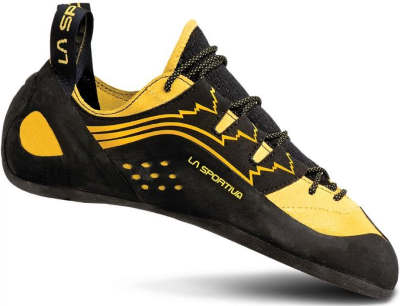
Is Friction Climbing Slab Climbing?
Yes, most friction climbing is slab climbing – but not all. Most people mean slab when the talk about friction climbing. Friction slab is a type of slab climbing where there aren’t many holds, and most of your foot and hand holds are mainly about friction rather than a defined edge or hold.
Friction climbing can also mean when holds are just about friction. Some of the hardest boulders in the world don’t have real holds, just areas of friction either side of a boulder that are pulled in on with the arms, often called “compression” routes.
You can also use a technique called “stemming” or “bridging” where you are pushing outwards using mainly friction. This is common on “dihedrals” or inside corners, as well as “chimneys” aka two separate walls within reach. Take a look at Johnny Dawes (again) on the “The Quarryman” below, a legendary climb which goes from a tight dihedral corner to a full on tip toes chimney!
What Is The Hardest Slab Climb In The World?
The hardest slab climb in the world is “Cryptography” 9b (5.15b) and was climbed by Alessandro Zeni in early 2020. It’s a linkup of two already very hard routes, “Bain de Sang” 9a and “Bimbaluna” 9a/+ that are next to each other. The new route is graded because it takes the hardest part of both climbs, adds a new traverse between them, and doesn’t allow for the rests that previous climbs did.
It’s the hardest slab climb in the world because it’s almost totally blank of decent holds, at a high angle that isn’t quite vertical. Almost every handhold is a tiny crimp, with the crux being a pair of single finger pockets. Alessandro wore the La Sportiva Katana Lace‘s that we recommend in our best slab climbing shoes article.
There’s also another climb in the running for hardest slab climb in the UK. “Meltdown” is a 9a route in the same Dinorwig slate quarry in Llanberis, Wales that “The Quarryman” above is. It was first found by Johnny Dawes back in 1985, then sent for the first time by James McHaffie in 2012, then repeated by Ignacio Mulero in 2019.
